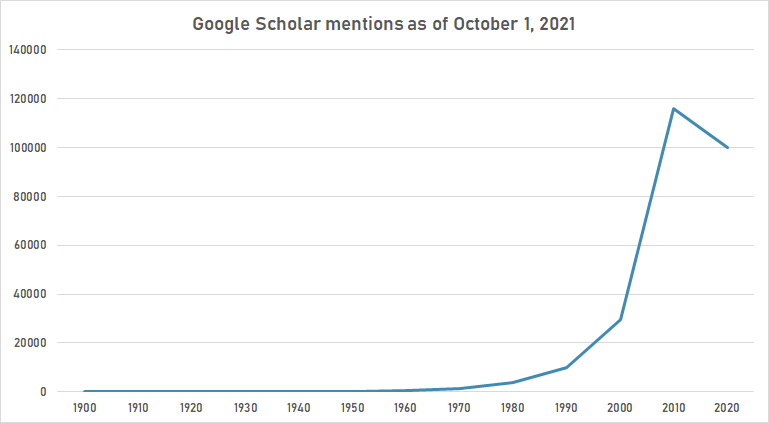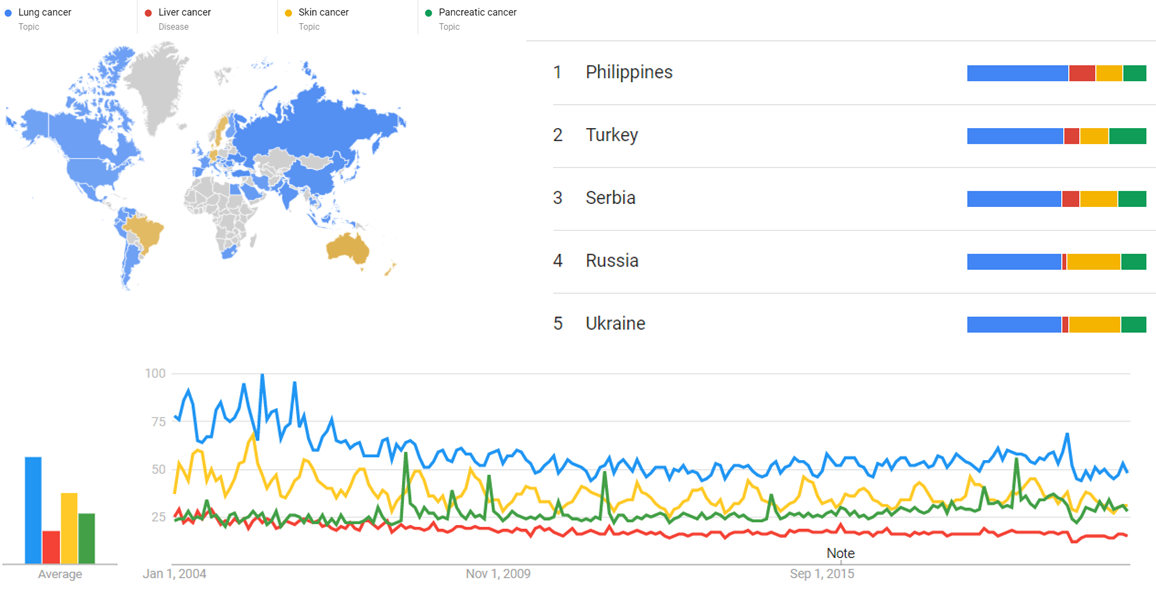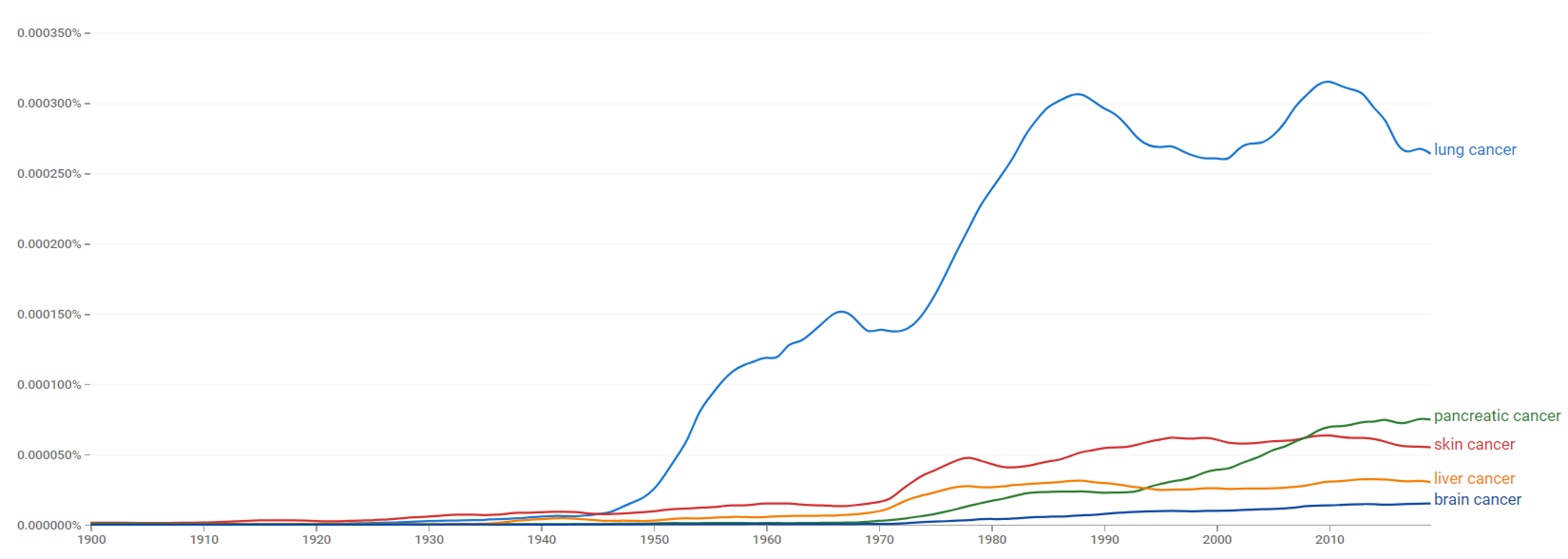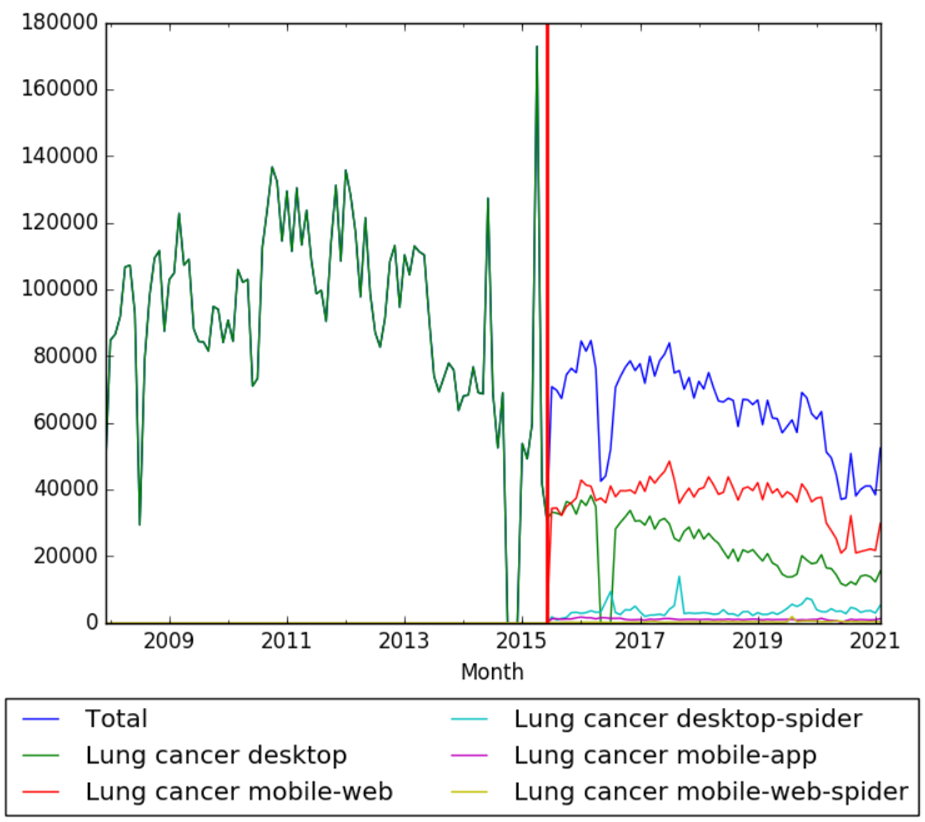Timeline of lung cancer
This is a timeline of lung cancer, describing especially major discoveries, advances in treatment and major organizations.
Big picture
| Year/period | Key developments |
|---|---|
| 19th century | Lung cancer is very uncommon before the 20th century. Malignant lung tumors make up only about 1% of all cancers on records.[1] |
| 1900s | Lung cancer incidence start to rise early in the 20th century, though very few cases are reported in the medical literature.[1][2] |
| 1930s onward | Lung cancer rates start to increase exponentially (peak at 100/100,000 for men in the late 1980s and currently a plateau at 55/100,000 for women) as a consequence massive consumption of cigarettes worldwide. Rates in never smokers remain stable (~10 to 20/100,000). |
| 1960s onward | Rates of adenocarcinoma of the lung start to rise relative to other types of lung cancer, partly due to the introduction of cigarette filters.[3] |
| 1970s | Successful chemotherapy regimens are developed for lung cancer.[4] |
| 1990s | Several new chemotherapy drugs for non-small cell lung cancer are developed, including paclitaxel, docetaxel, vinorelbine and gemcitabine.[5] |
| 2000s onward | Today, lung cancer is a top cause of death among both men and women at a worldwide level, and ranks high in both incidence and mortality. Smoking is still considered to be the principal cause of lung cancer.[6][7] |
Full timeline
| Year/period | Type of event | Event | Location |
|---|---|---|---|
| 1761 | Discovery | Lung cancer is first recognized as a disease.[8] | |
| 1810 | Development | Different aspects of lung cancer are described.[8] | |
| 1870–1879 | Crisis | Miners working at mines rich in radon gas, are found to develop a disproportionate amount of lung disease, eventually recognized as lung cancer.[9] | Germany |
| 1899–1911 | Report | Diagnosing lung cancer in living patients are rare. Cases identified in autopsies are very uncommon (i.e., fewer than 1/1000).[8] | |
| 1929 | Discovery | German physician Fritz Lickint publishes a paper showing that lung cancer patients are particularly likely to be smokers.[1] | |
| 1933 | Treatment | The first successful pneumonectomy for lung cancer is performed.[10] | |
| 1933 | Organization | The Union for International Cancer Control is founded as an NGO. Its purpose is to help the global health community accelerate the fight against cancer.[11] | Geneva, Switzerland (Serves worldwide) |
| 1958 | Treatment | Fluorouracil is developed as a chemotherapy drug for treating many cancers, including lung cancer.[12] | |
| 1959–1972 | Study | Cancer Prevention Study I begins. 1 million men and women are recruited. The study will demonstrate that sharp increase in lung cancer death rates is related to cigarette smoking[13] | United States |
| 1960–1969 | Discovery | Radon is confirmed to be a cause of lung cancer.[14] | |
| 1964 | The Surgeon General of the United States recommends the population not to smoke.[15] | United States | |
| 1965 | Organization | The International Agency for Research on Cancer (IARC) is founded as an intergovernmental agency forming part of the World Health Organization of the United Nations. Its role is to conduct and coordinate research into the causes of cancer.[16] | Lyon, France |
| 1969 | Report | New edition of a handbook changes radically from the previous one. The role of cigarette smoking is described in detail. Air pollution is mentioned. Difference in incidence between urban and rural areas is acknowledged.[1] | |
| 1986 | Discovery | Passive smoking is formally declared a carcinogen by the International Agency for Research on Cancer. A number of cities around the world start to ban indoor smoking in the years that follow.[5] | |
| 1987 | Discovery | Researchers discover that epidermal growth factor receptor (EGFR) plays an important role in the growth and spread of non-small-cell lung carcinoma.[5] | |
| 1990–1992 | Treatment | Two studies show that combining chemotherapy and radiation prolongs survival for non-small cell lung cancer. This treatment approach soon becomes standard.[5] | |
| 1993 | Treatment | Researchers demonstrate simultaneous radiation and chemotherapy dramatically improves the effectiveness of treatment for patients with early-stage small-cell carcinoma, compared to starting radiation later in the course of treatment.[5] | |
| 1995 | Treatment | An analysis of data from more than 50 clinical trials affirms benefits of chemotherapy for advanced non-small-cell lung carcinoma, concluding that cisplatin chemotherapy, along with surgery, radiation therapy or supportive care, substantially extends survival.[5] | |
| 1995 | Organization | Lung Cancer Alliance is founded as an NGO. Its stated purpose is to promote lung cancer awareness, reduce lung cancer mortality and end the stigma associated with lung cancer.[11] | Washington D.C., United States |
| 1996 | Treatment | Topotecan is approved as second round of treatment for small-cell lung carcinoma.[5] | |
| 1999 | Discovery | Cranial radiation is found to reduce risk of small-cell carcinoma spreading to the brain.[5] | |
| 1999 | Discovery | Study finds that twice-daily radiation to the chest, together with chemotherapy, prolongs survival against small cell lung carcinoma, compared with once-daily radiation and chemotherapy.[5] | |
| 2000 | Discovery | The Iowa Radon Lung Cancer Study demonstrates that household radon exposure is associated with increased risk of lung cancer.[5] | United States |
| 2001 | Organization | The Global Lung Cancer Coalition (GLCC) is established. GLCC aims to address the following issues: aims to address the following issues: placing lung cancer on the global healthcare agenda, changing public perceptions and lessen the stigma of lung cancer, empowering lung cancer patients to take an active role in their care, having impact in legislative or regulatory policies to optimize treatment and care.[11] | It comprises 28 non-government patient organizations from Argentina, Australia, Bulgaria, Canada, Denmark, Egypt, France, Germany, Ireland, Israel, Italy, Japan, Mexico, Netherlands, Norway, Portugal, Russia, Slovenia, Spain, Sweden, Switzerland, Turkey, United Kingdom and United States |
| 2003 | Treatment | FDA approves gefitinib for first-line treatment of patients with metastatic non-small-cell lung carcinoma.[17] | United States |
| 2005 | Policy | Bhutan becomes the first country to impose nationwide ban on the sale of tobacco products.[18] | Bhutan |
| 2006 | Organization | Women Against Lung Cancer in Europe is founded as nonprofit organization, with aims at supporting and helping lung cancer patients and their families and circulating accurate, correct and updated information about the disease in terms of prevention, diagnosis and therapy.[11] | Italy (active at national and international level) |
| 2007 | Organization | Lung Cancer Foundation of America (LCFA) is established with aims at improving survival against lung cancer through the funding on research.[11][19] | Marina Del Rey, California, United States |
| 2008 | Policy | Indian government bans smoking in public.[20] | India |
| 2010 | Organization | Lungevity Foundation is established as a nonprofit organization. It funds research into early detection and treatment of lung cancer.[11][21] | United States |
| 2010 | Organization | Global Resource For Advancing Cancer Education (GRACE) is founded. Its purpose is to provide expert-mediated information on current and emerging cancer management options in order to empower patients, caregivers, and health professionals to become direct partners in cancer care.[22] | Seattle, Washington, United States |
| 2012 | Report | According to the US National Lung Association, deaths due to lung cancer increase by about 3.5% in the period 1999–2012.[6] | |
| 2013 | The International Agency for Research on Cancer classifies air pollutants as leading causes of lung cancer.[23] | Lyon, France | |
| 2015 | Report | Lung cancer surpasses breast cancer as the leading cause of cancer deaths for women in rich countries.[24] | |
| 2016 | Discovery | Scientists discover drug combination that slows cell growth in a type of non small cell lung cancer, using trametinib and AZD2014. | The Institute of Cancer Research, London, UK |
Numerical and visual data
Google Scholar
The following table summarizes per-year mentions on Google Scholar as of October 1, 2021.
| Year | "lung cancer" |
|---|---|
| 1900 | 13 |
| 1910 | 3 |
| 1920 | 9 |
| 1930 | 27 |
| 1940 | 42 |
| 1950 | 195 |
| 1960 | 647 |
| 1970 | 1,290 |
| 1980 | 3,880 |
| 1990 | 9,760 |
| 2000 | 29,400 |
| 2010 | 116,000 |
| 2020 | 100,000 |

Google Trends
The comparative chart below shows Google Trends data for Lung cancer (Topic), Liver cancer (Disease), Skin cancer (Topic) and Pancreatic cancer (Topic), from January 2004 to March 2021, when the screenshot was taken. Interest is also ranked by country and displayed on world map.[25]

Google Ngram Viewer
The comparative chart below shows Google Ngram Viewer data for lung cancer, skin cancer, pancreatic cancer, liver cancer, and brain cancer, from 1900 to 2019. [26]

Wikipedia Views
The chart below shows pageviews of the English Wikipedia article Lung cancer, on desktop from December 2007, and on mobile-web, desktop-spider, mobile-web-spider and mobile app, from July 2015; to February 2021.[27]

See also
- Timeline of tobacco smoking and disease
- Timeline of brain cancer
- Timeline of colorectal cancer
- Timeline of pancreatic cancer
- Timeline of kidney cancer
- Timeline of liver cancer
- Timeline of bladder cancer
- Timeline of cervical cancer
- Timeline of leukemia
- Timeline of lymphoma
References
- ↑ 1.0 1.1 1.2 1.3 Witschi, H (November 2001). "A Short History of Lung Cancer". Toxicological Sciences. 64: 4–6. doi:10.1093/toxsci/64.1.4. PMID 11606795.
- ↑ Adler, I (1912). Primary Malignant Growths of the Lungs and Bronchi. New York: Longmans, Green, and Company. OCLC 14783544. OL 24396062M., cited in Spiro SG, Silvestri GA (2005). "One hundred years of lung cancer". American Journal of Respiratory and Critical Care Medicine. 172 (5): 523–529. doi:10.1164/rccm.200504-531OE. PMID 15961694.
- ↑ Charloux A, Quoix E, Wolkove N, et al. (February 1997). "The increasing incidence of lung adenocarcinoma: reality or artefact? A review of the epidemiology of lung adenocarcinoma". International Journal of Epidemiology. 26 (1): 14–23. doi:10.1093/ije/26.1.14. PMID 9126499.
- ↑ Cohen, MH; Creaven, PJ; Fossieck, BE; et al. (1977). "Intensive chemotherapy of small cell bronchogenic carcinoma". Cancer Treat Rep. 61: 349–54. PMID 194691.
{{cite journal}}: Explicit use of et al. in:|last4=(help) - ↑ 5.00 5.01 5.02 5.03 5.04 5.05 5.06 5.07 5.08 5.09 "Progress & Timeline". Retrieved 26 August 2016.
- ↑ 6.0 6.1 "Lung Cancer: Signs, Symptoms, Types & Treatment". Retrieved 28 August 2016.
- ↑ World Cancer Report 2014. World Health Organization. 2014. pp. Chapter 1.1. ISBN 9283204298.
- ↑ 8.0 8.1 8.2 Yang, P (2011). "Lung Cancer in Never Smokers". Semin Respir Crit Care Med. 32: 10–21. doi:10.1055/s-0031-1272865. PMC 3404817. PMID 21500120.
- ↑ Greenberg, M; Selikoff IJ (February 1993). "Lung cancer in the Schneeberg mines: a reappraisal of the data reported by Harting and Hesse in 1879". Annals of Occupational Hygiene. 37 (1): 5–14. doi:10.1093/annhyg/37.1.5. PMID 8460878.
- ↑ Horn, L; Johnson DH (July 2008). "Evarts A. Graham and the first pneumonectomy for lung cancer". Journal of Clinical Oncology. 26 (19): 3268–3275. doi:10.1200/JCO.2008.16.8260. PMID 18591561.
- ↑ 11.0 11.1 11.2 11.3 11.4 11.5 "IASLC". Retrieved 26 August 2016.
- ↑ "Fifty Years of Milestones in Cancer Research". Retrieved 28 August 2016.
- ↑ "History of the Cancer Prevention Studies". Retrieved 28 August 2016.
- ↑ Samet, JM (2011). "Radiation and cancer risk: a continuing challenge for epidemiologists". Environ Health. 10 Suppl 1: S4. doi:10.1186/1476-069X-10-S1-S4. PMC 3073196. PMID 21489214.
{{cite journal}}: CS1 maint: unflagged free DOI (link) - ↑ "Surgeon General of the United States" (PDF). Retrieved 28 August 2016.
- ↑ "IARC" (PDF). Retrieved 21 November 2016.
- ↑ "FDA approves targeted therapy for first-line treatment of patients with a type of metastatic lung cancer". Retrieved 26 August 2016.
- ↑ "Bhutan's smokers face public ban". Retrieved 26 August 2016.
- ↑ "Lung Cancer Foundation of America". Retrieved 21 November 2016.
- ↑ "Indian ban on smoking in public". Retrieved 26 August 2016.
- ↑ "Lungevity". Retrieved 28 August 2016.
- ↑ "GRACE". Retrieved 21 November 2016.
- ↑ "Air pollution causes lung cancer, warns World Health Organisation". Retrieved 28 August 2016.
- ↑ "Lung cancer now top cancer killer for women in rich nations". Retrieved 28 August 2016.
- ↑ "Lung cancer, Liver cancer, Skin cancer and Pancreatic cancer". Google Trends. Retrieved 30 March 2021.
- ↑ "Lung cancer, skin cancer, pancreatic cancer, liver cancer and brain cancer". books.google.com. Retrieved 30 March 2021.
- ↑ "Lung cancer". wikipediaviews.org. Retrieved 9 March 2021.
Template:Cancer timeline Category:Lung cancer Category:Health-related timelines Category:Medicine timelines